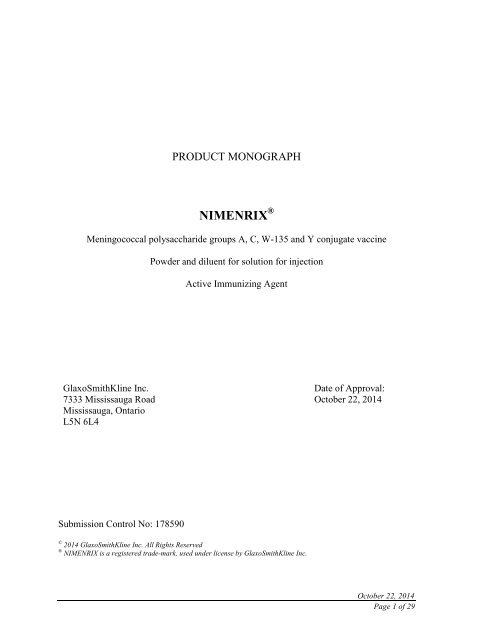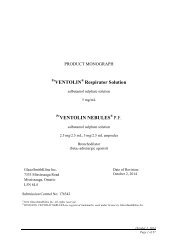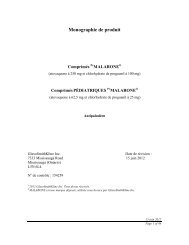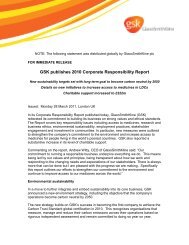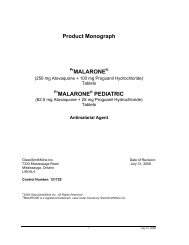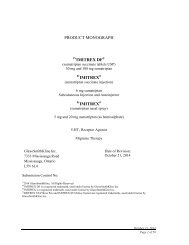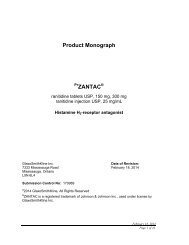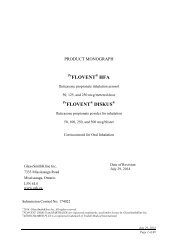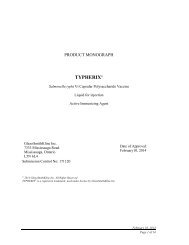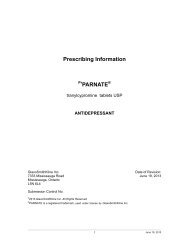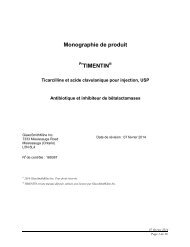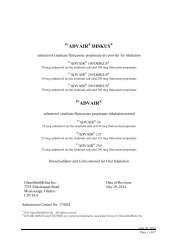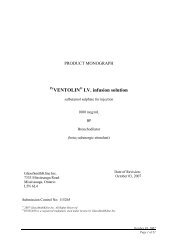NIMENRIX⢠- GlaxoSmithKline
NIMENRIX⢠- GlaxoSmithKline
NIMENRIX⢠- GlaxoSmithKline
Create successful ePaper yourself
Turn your PDF publications into a flip-book with our unique Google optimized e-Paper software.
PRODUCT MONOGRAPH<br />
NIMENRIX ®<br />
Meningococcal polysaccharide groups A, C, W-135 and Y conjugate vaccine<br />
Powder and diluent for solution for injection<br />
Active Immunizing Agent<br />
<strong>GlaxoSmithKline</strong> Inc.<br />
7333 Mississauga Road<br />
Mississauga, Ontario<br />
L5N 6L4<br />
Date of Approval:<br />
October 22, 2014<br />
Submission Control No: 178590<br />
© 2014 <strong>GlaxoSmithKline</strong> Inc. All Rights Reserved<br />
® NIMENRIX is a registered trade-mark, used under license by <strong>GlaxoSmithKline</strong> Inc.<br />
October 22, 2014<br />
Page 1 of 29
Table of Contents<br />
PART I: HEALTH PROFESSIONAL INFORMATION ............................................ 3<br />
SUMMARY PRODUCT INFORMATION ........................................................... 3<br />
DESCRIPTION....................................................................................................... 3<br />
INDICATIONS AND CLINICAL USE ................................................................. 4<br />
CONTRAINDICATIONS ...................................................................................... 4<br />
WARNINGS AND PRECAUTIONS ..................................................................... 4<br />
ADVERSE REACTIONS ....................................................................................... 6<br />
DRUG INTERACTIONS ..................................................................................... 11<br />
DOSAGE AND ADMINISTRATION ................................................................. 12<br />
OVERDOSAGE ................................................................................................... 12<br />
ACTION AND CLINICAL PHARMACOLOGY ............................................... 12<br />
STORAGE AND STABILITY ............................................................................. 13<br />
SPECIAL HANDLING INSTRUCTIONS .......................................................... 13<br />
DOSAGE FORMS, COMPOSITION AND PACKAGING ................................ 14<br />
PART II: SCIENTIFIC INFORMATION .................................................................. 16<br />
PHARMACEUTICAL INFORMATION ............................................................. 16<br />
CLINICAL TRIALS ............................................................................................. 16<br />
TOXICOLOGY .................................................................................................... 24<br />
REFERENCES ..................................................................................................... 25<br />
PART III: CONSUMER INFORMATION................................................................. 27<br />
October 22, 2014<br />
Page 2 of 29
NIMENRIX ®<br />
Meningococcal polysaccharide groups A, C, W-135 and Y conjugate vaccine<br />
PART I: HEALTH PROFESSIONAL INFORMATION<br />
SUMMARY PRODUCT INFORMATION<br />
Route of<br />
Administration<br />
Intramuscular<br />
Injection<br />
Dosage Form / Strength<br />
Powder and diluent for solution for injection/<br />
Neisseria meningitidis serogroup A<br />
polysaccharide 1<br />
5 micrograms<br />
Neisseria meningitidis serogroup C<br />
polysaccharide 1<br />
5 micrograms<br />
Neisseria meningitidis serogroup W-135<br />
polysaccharide 1<br />
5 micrograms<br />
Neisseria meningitidis serogroup Y<br />
polysaccharide 1<br />
5 micrograms<br />
1 conjugated to tetanus toxoid carrier protein 44 micrograms<br />
Clinically Relevant<br />
Nonmedicinal<br />
Ingredients<br />
Sucrose<br />
Trometamol<br />
Sodium chloride<br />
For a complete listing<br />
see Dosage Forms,<br />
Composition and<br />
Packaging section.<br />
DESCRIPTION<br />
NIMENRIX ® (meningococcal polysaccharide groups A, C, W-135 and Y conjugate<br />
vaccine) is a tetravalent meningococcal polysaccharide conjugated vaccine consisting of<br />
Neisseria meningitidis capsular polysaccharides A, C, W-135 and Y each coupled to<br />
tetanus toxoid as a carrier protein. The Neisseria meningitidis serogroups A and C<br />
polysaccharides are conjugated with an adipic dihydrazide (AH) spacer and indirectly<br />
conjugated to the tetanus toxoid whereas the W-135 and Y polysaccharides are conjugated<br />
directly to tetanus toxoid.<br />
The vaccine does not contain any preservatives or adjuvants.<br />
October 22, 2014<br />
Page 3 of 29
INDICATIONS AND CLINICAL USE<br />
NIMENRIX ® is indicated for the active immunization of individuals from 12 months to 55<br />
years of age against invasive meningococcal diseases caused by Neisseria meningitidis<br />
serogroups A, C, W-135 and Y.<br />
CONTRAINDICATIONS<br />
NIMENRIX ® should not be administered to subjects with known hypersensitivity to any<br />
component of the vaccine. For a complete listing, see the DOSAGE FORMS,<br />
COMPOSITION AND PACKAGING section.<br />
WARNINGS AND PRECAUTIONS<br />
General<br />
NIMENRIX ® should under no circumstances be administered intravascularly,<br />
intradermally or subcutaneously.<br />
It is good clinical practice to precede vaccination by a review of the medical history<br />
(especially with regard to previous vaccination and possible occurrence of undesirable<br />
effects) and a clinical examination.<br />
As with all injectable vaccines, appropriate medical treatment and supervision should<br />
always be readily available in case of a rare anaphylactic event following the<br />
administration of the vaccine.<br />
Syncope (fainting) can occur following, or even before, any vaccination as a psychogenic<br />
response to the needle injection. It is important that procedures are in place to avoid injury<br />
from faints.<br />
NIMENRIX ® will only confer protection against Neisseria meningitidis serogroups A, C,<br />
W-135 and Y. The vaccine will not protect against other Neisseria meningitidis serogroups.<br />
Although NIMENRIX ® contains tetanus toxoid, this vaccine does not substitute for tetanus<br />
immunization.<br />
A more rapid waning of serum bactericidal antibody titres against MenA than for other<br />
serogroups (C, W-135, Y) has been observed when using human complement in the assay<br />
(see CLINICAL TRIALS). In individuals expected to be at particular risk of exposure to<br />
MenA and who received a first dose of NIMENRIX ® more than one year earlier,<br />
consideration may be given to administering a second dose of NIMENRIX ® . Available data<br />
indicate that a second dose will elicit an anamnestic immune response to all four<br />
meningococcal types in the vaccine. Currently there is very limited information available<br />
on the safety of a second dose of NIMENRIX ® .<br />
October 22, 2014<br />
Page 4 of 29
Febrile Illness<br />
As with other vaccines, vaccination with NIMENRIX ® should be postponed in subjects<br />
suffering from an acute severe febrile illness. The presence of a minor infection, such as a<br />
cold, should not result in the deferral of vaccination.<br />
Hematologic<br />
As with other vaccines administered intramuscularly, NIMENRIX ® should be given with<br />
caution to individuals with thrombocytopenia or any coagulation disorder since bleeding<br />
may occur following an intramuscular administration to these subjects.<br />
Immune<br />
As with any vaccine, a protective immune response may not be elicited in all vaccinees.<br />
It may be expected that in patients receiving immunosuppressive treatment or patients with<br />
immunodeficiency, an adequate immune response may not be elicited.<br />
Safety and immunogenicity have not been assessed in patients with increased susceptibility<br />
to meningococcal infection due to conditions such as terminal complement deficiencies and<br />
anatomic or functional asplenia. In these individuals, an adequate immune response may<br />
not be elicited.<br />
Special Populations<br />
Pregnant Women: There is limited experience with use of NIMENRIX ® in pregnant<br />
women.<br />
Animal studies with NIMENRIX ® do not indicate direct or indirect harmful effects with<br />
respect to fertility, pregnancy, embryo/fetal development, parturition or post-natal<br />
development (see TOXICOLOGY).<br />
NIMENRIX ® should be used during pregnancy only when clearly needed, and the possible<br />
advantages outweigh the potential risks for the fetus.<br />
Nursing Women: The safety of NIMENRIX ® when administered to breastfeeding women<br />
has not been evaluated. It is unknown whether NIMENRIX ® is excreted in human breast<br />
milk.<br />
NIMENRIX ® should only be used during breast-feeding when the possible advantages<br />
outweigh the potential risks.<br />
Pediatrics: The safety and immunogenicity of NIMENRIX ® in children under 12 months<br />
of age have not been established<br />
October 22, 2014<br />
Page 5 of 29
ADVERSE REACTIONS<br />
Adverse Drug Reaction Overview<br />
The safety profile is based on a pooled analysis on 8,108 subjects who have been<br />
vaccinated with one dose of NIMENRIX ® in clinical studies. The pooled analysis includes<br />
data for 2,237 toddlers (12 months to 23 months), 1,809 children (2 to 10 years), 2,011<br />
adolescents (11 to 17 years) and 2,051 adults (18 – 55 years). In addition, a descriptive<br />
study provides safety data from 274 individuals aged 56 years and older and who have been<br />
vaccinated with one dose of NIMENRIX ® .<br />
Clinical Trial Adverse Drug Reactions<br />
Because clinical trials are conducted under very specific conditions the adverse reaction<br />
rates observed in the clinical trials may not reflect the rates observed in practice and<br />
should not be compared to the rates in the clinical trials of another drug. Adverse drug<br />
reaction information from clinical trials is useful for identifying drug-related adverse<br />
events and for approximating rates.<br />
Solicited Adverse Reactions:<br />
Infants 12 to 23 months old<br />
In Study MenACWY-TT-039, healthy children 12 through 23 months of age were<br />
administered one dose of NIMENRIX ® either alone or co-administered with a first dose of<br />
PRIORIX-TETRA ® , 1 dose of PRIORIX-TETRA ® or 1 dose of a licensed MenC-CRM 197<br />
(MenC-CRM) vaccine.<br />
Table 1 presents the rates of solicited symptoms reported during the 4-day post-vaccination<br />
period in the Co-administered (Co-ad), NIMENRIX ® , PRIORIX-TETRA ® and MenC-<br />
CRM groups.<br />
October 22, 2014<br />
Page 6 of 29
Table 1<br />
Study MenACWY-TT-039: Percentage of subjects with solicited local<br />
and general symptoms reported during the 4-day (Days 0-3) postvaccination<br />
period (Total vaccinated cohort)<br />
Type NIMENRIX ®<br />
+ PRIORIX-<br />
TETRA ®<br />
N=375<br />
NIMENRIX ®<br />
N=367<br />
PRIORIX-<br />
TETRA ®<br />
N=124<br />
MenC-CRM<br />
N=123<br />
Local Symptoms, %<br />
Pain All 24.3 29.2 17.7 25.2<br />
Grade 3 0.3 0.8 0.0 0.0<br />
Redness All 35.5 37.1 38.7 31.7<br />
> 30 mm 1.9 4.4 0.0 0.0<br />
Swelling All 13.9 18.8 5.6 8.1<br />
> 30 mm 2.4 4.1 0.0 0.0<br />
General Symptoms, %<br />
Type NIMENRIX ®<br />
+ PRIORIX-<br />
TETRA ®<br />
N=375<br />
NIMENRIX ®<br />
N=367<br />
PRIORIX-<br />
TETRA ®<br />
N=124<br />
MenC-CRM<br />
N=124<br />
Drowsiness All 32.5 28.1 23.4 32.3<br />
Grade 3 0.3 0.0 0.8 0.0<br />
Fever (Rectally) All<br />
14.9 9.3 11.3 12.9<br />
(>38 o C)<br />
>40 o C 0.0 0.0 0.8 0.0<br />
Irritability All 50.7 40.9 38.7 43.5<br />
Grade 3 0.8 0.5 1.6 0.0<br />
Loss of appetite All 28.5 22.9 23.4 26.6<br />
Grade 3 0.3 0.0 0 0.0<br />
N= number of subjects with the dose documented<br />
%= percentage of subjects reporting the symptom at least once<br />
Redness was the most frequently reported solicited local symptom in each group after each<br />
vaccination (38.7% in the PRIORIX-TETRA ® group, 35.5% in the Co-ad group and 37.1%<br />
in the NIMENRIX ® group and 31.7% in the MenC-CRM group).<br />
Irritability was the most frequently reported solicited general symptom in the 4 groups<br />
(50.7% in the Co-ad group, 40.9% in the NIMENRIX ® group, 38.7% in the PRIORIX-<br />
TETRA ® group and 43.5% in the MenC-CRM group).<br />
Children (2-10 Years Old), Adolescents (10-25 Years Old), and Adults (18-55 Years<br />
Old)<br />
Children (2-5 Years Old)<br />
In Study MenACWY-TT-081, healthy children aged 2 through 10 years of age were<br />
administered 1 dose of NIMENRIX ® or 1 dose of a licensed MenC-CRM vaccine.<br />
Table 2 presents the percentage of subjects (aged 2 through 5 years of age) with solicited<br />
adverse reactions during the 4-day post vaccination period in the NIMENRIX ® and MenC-<br />
CRM groups.<br />
October 22, 2014<br />
Page 7 of 29
Table 2<br />
MenACWY-TT-081: Percentage of subjects with solicited local and<br />
general symptoms reported during the 4-day (Days 0-3) postvaccination<br />
period (Total vaccinated cohort), subjects 2 through 5 years<br />
of age<br />
Type NIMENRIX ®<br />
N=162<br />
MenC-CRM<br />
N=53<br />
Local Symptoms, %<br />
Pain All 27.8 28.3<br />
Grade 3 0.0 1.9<br />
Redness All 35.2 39.6<br />
>30 mm 6.8 15.1<br />
Swelling All 26.5 24.5<br />
>30 mm 4.3 5.7<br />
General Symptoms, %<br />
Drowsiness All 14.2 11.3<br />
Grade 3 0.0 1.9<br />
Fever/(Orally) All (>37.5 o C) 5.6 5.7<br />
>39.5 o C 0.0 0.0<br />
Irritability All 15.4 11.3<br />
Grade 3 0.6 1.9<br />
Loss of Appetite All 10.5 9.4<br />
Grade 3 0.0 0.0<br />
N= number of subjects with the dose documented<br />
%= percentage of subjects reporting the symptom at least once<br />
Redness was the most frequently reported solicited local symptom in each group (35.2%<br />
and 39.6% of the subjects in the NIMENRIX ® group and MenC-CRM group,<br />
respectively).<br />
Irritability was the most frequently reported solicited general symptom in each group<br />
(15.4% and 11.3% of the subjects in the NIMENRIX ® group and MenC-CRM group,<br />
respectively). Drowsiness was also reported by 11.3% of the subjects in the MenC-CRM<br />
group, as compared to 14.2% of the subjects in the NIMENRIX ® group. Fever ≥ 37.5°C<br />
was reported by 5.6% of the subjects in the NIMENRIX ® group and 5.7% of the subjects in<br />
the MenC-CRM. The majority of fevers were measured by the rectal route (66.7% in the<br />
NIMENRIX ® group and 100% in the MenC-CRM group).<br />
Children aged 6-10 years<br />
Table 3 includes the percentage of subjects (aged 6 through 10 years of age) with solicited<br />
adverse reactions during the 4-day post vaccination period in the NIMENRIX ® and MenC-<br />
CRM groups.<br />
Pain was the most frequently reported solicited local symptom in each group (43.9% and<br />
54.0% of the subjects in the NIMENRIX ® group and MenC-CRM group, respectively).<br />
Fatigue was the most frequently reported solicited general symptom in each group (22.3%<br />
and 22.0% of the subjects in the NIMENRIX ® group and MenC-CRM group, respectively).<br />
Fever ≥ 37.5°C was reported in 6.8% of the subjects in the NIMENRIX ® group and 2.0%<br />
of the subjects in the MenC-CRM group.<br />
October 22, 2014<br />
Page 8 of 29
Adolescents aged 10-25 years<br />
In Study MenACWY-TT-071, healthy subjects aged 10 through 25 years of age were<br />
administered 1 dose of NIMENRIX ® or 1 dose of MENACTRA ® (ACWY-DT vaccine).<br />
Table 3 includes the percentage of subjects (aged 10 through 25 years of age) with solicited<br />
adverse reactions during the 4-day post vaccination period in the NIMENRIX ® and<br />
MENACTRA ® groups.<br />
The most common solicited local symptom during the 4-day post-vaccination period was<br />
pain at the injection site, reported by 51.4% and 55.4% of subjects in the NIMENRIX ® and<br />
MENACTRA ® groups, respectively. A much smaller percentage of these subjects reported<br />
pain with grade 3 intensity, ranging between 0.6% and 2.4% across all vaccine groups.<br />
The incidence of redness at the injection site was 25.8% and 20.3% of subjects in the<br />
NIMENRIX ® and MENACTRA ® groups, respectively. The incidence of swelling was<br />
19.1% and 13.5% of subjects, respectively. The majority of these events were grade 1 in<br />
intensity. Grade 3 events of redness (i.e. > 50 mm in diameter) were reported by 3 and 6<br />
subjects in the NIMENRIX ® and MENACTRA ® groups, respectively. Grade 3 events of<br />
swelling (i.e. > 50 mm in diameter) were reported by 3 subjects each of the two vaccine<br />
groups.<br />
The most common solicited general symptom was fatigue with an incidence of 27.3% to<br />
29.2% across the two vaccine groups. Headache was reported by 25.5% to 26.4% and<br />
gastrointestinal symptoms by 13.1% to 13.5% of subjects across the two vaccine groups.<br />
Adults aged 18-55 years<br />
In Study MenACWY-TT-035, healthy adults aged 18 through 55 years of age were<br />
administered either 1 dose of NIMENRIX ® , 1 dose of a licensed ACWY-PS<br />
(polysaccharide) vaccine, or 1 dose of NIMENRIX ® co-administered with a licensed<br />
influenza vaccine, FLUARIX ® .<br />
Table 3 includes the percentage of subjects (aged 18 through 55 years of age) with solicited<br />
adverse reactions during the 4-day post vaccination period in the NIMENRIX ® , ACWY-PS<br />
and Co-administered groups.<br />
Pain was the most frequently reported solicited local symptom in each group (19.4% in the<br />
NIMENRIX ® group, 21.9% in the Co-administered group and 13.5% in the ACWY-PS<br />
group). Headache was the most frequently reported solicited general symptom in each<br />
group (16.3% in the NIMENRIX ® group, 14.2% in the ACWY-PS group, and 13.3% in the<br />
Co-administered group).<br />
October 22, 2014<br />
Page 9 of 29
Table 3<br />
Percentage of subjects with solicited local and general symptoms<br />
reported during the 4-day (Days 0-3) post-vaccination period (Total<br />
vaccinated cohort), subjects 6 through 55 years of age<br />
MenACWY-TT-081 MenACWY-TT-071 MenACWY-TT- 035<br />
Age 6-10 Years old 10-25 Years old 18-55 Years old<br />
Type NIMENRIX ®<br />
N=148<br />
MenC<br />
N=50<br />
NIMENRIX ®<br />
N=329<br />
MENACTRA ®<br />
N=325<br />
NIMENRIX ®<br />
N=927<br />
NIMENRIX ®<br />
+ FLUARIX ®<br />
N=105<br />
ACWY-<br />
PS<br />
N=310<br />
Local Symptoms, %<br />
Pain All 43.9 54.0 51.4 55.4 19.4 21.9 13.5<br />
Grade 3 2.0 6.0 2.4 0.6 0.4 1.0 0.3<br />
Redness All 39.2 38.0 25.8 20.3 8.8 5.7 4.5<br />
>50 mm 6.1 10.0 0.9 1.8 1.3 0.0 0.0<br />
Swelling All 29.7 30.0 19.1 13.5 7.9 1.0 1.9<br />
>50 mm 2.7 6.0 0.9 0.9 1.1 0.0 0.0<br />
General Symptoms, %<br />
Type NIMENRIX ®<br />
N=148<br />
MenC<br />
N=50<br />
NIMENRIX ®<br />
N=329 MENACTRA ®<br />
N=326<br />
NIMENRIX ®<br />
N=927<br />
NIMENRIX ®<br />
+ FLUARIX ®<br />
N=105<br />
ACWY-<br />
PS<br />
N=310<br />
Fatigue All 22.3 22.0 29.2 27.3 12.3 9.5 9.7<br />
Grade 3 2.7 0.0 2.7 1.5 0.9 0.0 0.0<br />
Fever<br />
All<br />
6.8 2.0 5.2 4.9 4.0 2.9 4.5<br />
(>37.5 o C)<br />
>39.5 o C 0.0 0.0 0.3 0.0 0.2 0.0 0.6<br />
Gastrointestinal All 14.9 8.0 13.1 13.5 4.6 1.9 3.2<br />
Grade 3 0.7 0.0 1.2 1.2 0.2 0.0 0.3<br />
Headache All 20.3 8.0 26.1 25.5 16.3 13.3 14.2<br />
Grade 3 1.4 0.0 1.5 1.8 1.5 0.0 1.6<br />
N= number of subjects with the dose documented<br />
%= percentage of subjects reporting the symptom at least once<br />
Study 081 and Study 071: Fever (>37.5 o C) (Orally)<br />
Study 035: Fever (>37.5 o C) (Axillary)<br />
Adults aged > 55 years<br />
In a descriptive study a single dose of NIMENRIX ® was administered to 274 individuals<br />
aged 56 years and older. The adverse reactions reported in this study were already observed<br />
in younger age groups.<br />
Common and Uncommon Clinical Trial Adverse Drug Reactions<br />
Adverse reactions reported during clinical studies included in the safety pooled analysis:<br />
Common (≥ 1% to < 10%): Injection site hematoma<br />
Uncommon (≥ 0.1% to < 1%): insomnia, crying, hypoesthesia, dizziness, pruritus, rash,<br />
myalgia, pain in extremity, malaise, and injection site reaction (including induration,<br />
pruritus, warmth, anesthesia).<br />
October 22, 2014<br />
Page 10 of 29
Post-Market Adverse Drug Reactions<br />
General disorders and administration site conditions<br />
Rare (≥ 1/10,000 and
DOSAGE AND ADMINISTRATION<br />
Dosing Considerations<br />
NIMENRIX ® should be used in accordance with available official recommendations.<br />
Recommended Dose and Dosage Adjustment<br />
Primary vaccination<br />
A single 0.5 mL dose of the reconstituted vaccine is used for immunization.<br />
Booster vaccination<br />
The need for a booster dose in subjects primed with NIMENRIX ® has not been established.<br />
There are no data available in subjects previously vaccinated with a meningococcal C<br />
conjugate vaccine.<br />
NIMENRIX ® may be given in subjects who have previously been vaccinated with a plain<br />
polysaccharide meningococcal vaccine (see CLINICAL TRIALS).<br />
Administration<br />
NIMENRIX ® is for intramuscular injection only, preferably in the deltoid muscle.<br />
In children 12 to 23 months of age, NIMENRIX ® may also be administered in the<br />
anterolateral part of the thigh (see WARNINGS AND PRECAUTIONS and DRUG<br />
INTERACTIONS).<br />
The reconstituted vaccine is a clear colourless solution.<br />
The reconstituted vaccine should be inspected visually for any foreign particulate matter<br />
and/or variation of physical aspect prior to administration. In the event of either being<br />
observed, discard the vaccine.<br />
Any unused product or waste material should be disposed of in accordance with local<br />
requirements.<br />
OVERDOSAGE<br />
For management of a suspected drug overdose, contact your regional Poison Control<br />
Centre.<br />
ACTION AND CLINICAL PHARMACOLOGY<br />
Mechanism of Action<br />
Anti-capsular meningococcal antibodies protect against meningococcal diseases via<br />
complement mediated bactericidal killing. NIMENRIX ® induces the production of<br />
bactericidal antibodies against capsular polysaccharides of serogroups A, C, W-135 and Y<br />
October 22, 2014<br />
Page 12 of 29
when measured by assays using either rabbit complement (rSBA) or human complement<br />
(hSBA). By conjugating capsular polysaccharide to a protein carrier that contains T-cell<br />
epitopes, meningococcal conjugate vaccines like NIMENRIX ® change the nature of<br />
immune response to capsular polysaccharide from T-cell independent to T-cell dependent.<br />
Canadian epidemiological data is available on the Public Health Agency of Canada<br />
website: http://www.phac-aspc.gc.ca/im/vpd-mev/meningococcal-eng.php.<br />
STORAGE AND STABILITY<br />
Store in a refrigerator (2°C – 8°C). The diluent may also be stored at ambient temperature<br />
(25°C).<br />
Do not freeze. Protect from light.<br />
SPECIAL HANDLING INSTRUCTIONS<br />
In the absence of compatibility studies, NIMENRIX ® must not be mixed with other<br />
medicinal products.<br />
Instructions for reconstitution of the vaccine with the diluent presented in pre-filled<br />
syringe<br />
NIMENRIX ® must be reconstituted by adding the entire content of the pre-filled syringe of<br />
diluent to the vial containing the powder.<br />
To attach the needle to the syringe, refer to the below drawing.<br />
Note: However, the syringe provided with NIMENRIX ® might be slightly different<br />
(without screw thread) than the syringe described in the drawing. In that case, the needle<br />
should be attached without screwing.<br />
1. Holding the syringe barrel in one<br />
hand (avoid holding the syringe<br />
plunger), unscrew the syringe cap<br />
by twisting it anticlockwise.<br />
Needle protector<br />
Needle<br />
Syringe plunger<br />
Syringe barrel<br />
Syringe cap<br />
Syringe<br />
October 22, 2014<br />
Page 13 of 29
2. To attach the needle to the syringe,<br />
twist the needle clockwise into the<br />
syringe until you feel it lock (see<br />
drawing).<br />
3. Remove the needle protector, which<br />
on occasion can be a little stiff.<br />
Needle protector<br />
4. Add the diluent to the powder. After the addition of the diluent to the powder, the<br />
mixture should be well shaken until the powder is completely dissolved in the<br />
diluent.<br />
After reconstitution, the vaccine should be used immediately.<br />
A new needle should be used to administer the vaccine.<br />
Instructions for reconstitution of the vaccine with diluent presented in ampoules<br />
NIMENRIX ® must be reconstituted by adding the entire content of the ampoule of diluent<br />
to the vial containing the powder.<br />
To do so, break the top of the ampoule, draw up the diluent with a syringe and add the<br />
diluent to the powder.<br />
The mixture should be well shaken until the powder is completely dissolved in the diluent.<br />
After reconstitution, the vaccine should be used immediately.<br />
A new needle should be used to administer the vaccine.<br />
DOSAGE FORMS, COMPOSITION AND PACKAGING<br />
Dosage Form<br />
NIMENRIX ® (meningococcal polysaccharide groups A, C, W-135 and Y conjugate<br />
vaccine) is supplied as a sterile lyophilized white powder in a single dose vial.<br />
The diluent (sodium chloride and water for injections) is a sterile clear and colourless<br />
liquid supplied separately in a prefilled syringe or ampoule*.<br />
*Format not available in Canada.<br />
After reconstitution, NIMENRIX ® is a clear colourless solution.<br />
October 22, 2014<br />
Page 14 of 29
Composition<br />
After reconstitution, 1 dose (0.5 mL) contains:<br />
Active Ingredients<br />
Neisseria meningitidis serogroup A polysaccharide 1<br />
Neisseria meningitidis serogroup C polysaccharide 1<br />
Neisseria meningitidis serogroup W-135 polysaccharide 1<br />
Neisseria meningitidis serogroup Y polysaccharide 1<br />
5 micrograms<br />
5 micrograms<br />
5 micrograms<br />
5 micrograms<br />
1 conjugated to tetanus toxoid carrier protein 44 micrograms<br />
Excipients<br />
Powder:<br />
Sucrose<br />
Trometamol<br />
Diluent:<br />
Sodium chloride<br />
Water for Injections<br />
28 mg<br />
97 μg<br />
4.5 mg<br />
q.s. to 0.5 mL<br />
Packaging<br />
NIMENRIX ® is supplied in a 3 mL single dose glass vial. The diluent (0.5 mL) is supplied<br />
in a prefilled syringe or ampoule*.<br />
The vials, syringes, and ampoules* are made of neutral glass Type 1.<br />
NIMENRIX ® is available in pack sizes as follows:<br />
• Single dose vial packaged with pre-filled syringe of diluent with or without<br />
needles in pack sizes of 1 and 10.<br />
• Single dose vial packaged with ampoule* of diluent in pack sizes of 1, 10 or<br />
100.<br />
*Format not available in Canada.<br />
October 22, 2014<br />
Page 15 of 29
PART II: SCIENTIFIC INFORMATION<br />
PHARMACEUTICAL INFORMATION<br />
Drug Substance<br />
NIMENRIX ® is composed of the purified capsular polysaccharides of Neisseria<br />
meningitidis serogroups A, C, W-135 and Y, each conjugated to tetanus toxoid.<br />
CLINICAL TRIALS<br />
The immunogenicity of one dose of NIMENRIX ® has been evaluated in more than 8,000<br />
subjects aged ≥12 months.<br />
Vaccine efficacy was inferred from the demonstration of immunologic non-inferiority<br />
(based mainly on comparing proportions with rabbit complement serum bactericidal assay<br />
(rSBA) titres at least 1:8) to licensed meningococcal vaccines. Immunogenicity was<br />
measured by using rSBA or human complement serum bactericidal assay (hSBA) which<br />
are biomarkers for protective efficacy against meningococcal serogroups A, C, W-135 and<br />
Y.<br />
October 22, 2014<br />
Page 16 of 29
Table 4<br />
Study demographics and trial design<br />
Study # Study Objectives Trial design No. of study subjects § Mean age<br />
in Years<br />
(Range)<br />
12-23 months<br />
Men<br />
ACWY-TT<br />
-039<br />
Men<br />
ACWY-TT<br />
-081<br />
Men<br />
ACWY-TT<br />
-035<br />
Men<br />
ACWY-TT<br />
-071<br />
Men<br />
ACWY-TT<br />
-071<br />
Immunogenicity and safety<br />
compared to<br />
Meningococcal C-CRM 197<br />
conjugate (MenC-CRM)<br />
vaccine and concomitant<br />
administration with<br />
measles-mumps-rubellavaricella<br />
vaccine (MMRV)<br />
Immunogenicity and safety<br />
compared to MenC-CRM<br />
Lot-to-lot consistency;<br />
immunogenicity and safety<br />
compared to ACWY-PS<br />
and concomitant<br />
administration with<br />
influenza virus vaccine<br />
Immunogenicity and safety<br />
compared to quadrivalent<br />
meningococcal diphtheria<br />
toxoid conjugate vaccine<br />
(MENACTRA ® )<br />
Immunogenicity and safety<br />
compared to quadrivalent<br />
meningococcal diphtheria<br />
toxoid conjugate vaccine<br />
(MENACTRA ® )<br />
Men Immunogenicity, safety,<br />
ACWY-TT- and reactogenicity<br />
085 compared to ACWY-PS<br />
Open, randomized,<br />
controlled, multicentre<br />
2-10 years<br />
Open, randomized,<br />
controlled, multicentre<br />
10-55 years<br />
Partially doubleblinded,<br />
randomized,<br />
controlled, multicentre<br />
Observer-blinded,<br />
randomized,<br />
controlled, multicentre<br />
Observer-blinded,<br />
randomized,<br />
controlled, multicentre<br />
> 55 years<br />
Open, randomized,<br />
controlled<br />
Total=972<br />
NIMENRIX ® =366<br />
Co-admin =361<br />
MMRV=121<br />
MenC-CRM =124<br />
Total=395<br />
NIMENRIX ® =296<br />
MenC-CRM =99<br />
Total=1284<br />
NIMENRIX ® =885<br />
ACWY-PS=294<br />
Co-admin=105<br />
Total =951<br />
NIMENRIX ® =637<br />
MENACTRA ® =314<br />
Total =951<br />
NIMENRIX ® =637<br />
MENACTRA ® =314<br />
Total = 260<br />
NIMENRIX ® = 194<br />
ACWY-PS= 66<br />
§ Number of subjects in according-to-protocol (ATP) cohort for immunogenicity or persistence<br />
14.6<br />
months<br />
(12-19<br />
months)<br />
5.6<br />
(2-10)<br />
35.5<br />
(18-55)<br />
16.3<br />
(10-25)<br />
16.3<br />
(10-25)<br />
63.9<br />
(56-103)<br />
Gender<br />
Male/<br />
Female<br />
507/465<br />
191/204<br />
710/574<br />
464/487<br />
464/487<br />
178/82<br />
Study results<br />
Immunogenicity in toddlers aged 12-23 months<br />
In the clinical study MenACWY-TT-039, the immune response to vaccination with either<br />
NIMENRIX ® or a licensed meningococcal C-CRM 197 conjugate (MenC-CRM) vaccine was<br />
evaluated.<br />
October 22, 2014<br />
Page 17 of 29
NIMENRIX ® elicited a bactericidal antibody response against the four serogroups, with a<br />
response against serogroup C that was comparable to the one elicited by the licensed<br />
MenC-CRM vaccine in term of rSBA titres ≥8 (Table 5)<br />
Table 5<br />
Study MenACWY-TT-039: Percentage of subjects with rSBA titres<br />
equal to or above the cut off value of 1:8 at day 42 post vaccination<br />
Serogroup N NIMENRIX ® (95% CI) N Active<br />
Control<br />
(MenC-<br />
CRM)<br />
Difference in<br />
percentage (ACWY-<br />
TT minus MenC-<br />
CRM)*<br />
(95%CI)<br />
rSBA-Men A 354 99.7%<br />
- - -<br />
(98.4; 100)<br />
rSBA-Men C 354 99.7%<br />
(98.4; 100)<br />
121 97.5%<br />
(92.9; 99.5)<br />
2.20<br />
(0.29; 6.78)<br />
rSBA-MenW-135<br />
100%<br />
- - -<br />
354<br />
(99.0; 100)<br />
rSBA-Men Y<br />
100%<br />
- - -<br />
354<br />
(99.0; 100)<br />
N = number of subjects with results available<br />
% = percentage of subjects with titre within the specified range<br />
95% CI = 95% confidence interval; LL = Lower Limit, UL = Upper Limit<br />
ATP cohort for immunogenicity<br />
*LL of 95% CI is above non-inferiority limit of -10%.<br />
The Geometric Mean Titres (GMTs) for MenC 42 days after vaccination were higher in<br />
children who received NIMENRIX ® than those who received MenC-CRM (477.6 vs.<br />
212.3). GMTs ranged between 2205.0 and 2729.4 for serogroups A, W-135 and Y in the<br />
NIMENRIX ® group.<br />
In addition this study evaluated the immunogenicity for hSBA prior to and 42 days after the<br />
first vaccine dose with NIMENRIX ® or the control vaccine (MenC-CRM). At 42 days<br />
after vaccination, 98.5% of the subjects in the NIMENRIX ® group and 81.9% of subjects in<br />
the MenC-CRM group had hSBA-MenC titres ≥ 8. In the NIMENRIX ® group the<br />
percentage of subjects with hSBA titres ≥ 8 ranged between 77.2% and 87.5 % for<br />
serogroups A, W-135 and Y.<br />
Immunogenicity in children aged 2 to 10 years<br />
In study (MenACWY-TT-081) conducted in subjects aged 2-10 years, one group of<br />
subjects received a dose of NIMENRIX ® and a second group a dose of a licensed MenC-<br />
CRM vaccine as a comparator.<br />
October 22, 2014<br />
Page 18 of 29
Table 6<br />
Study MenACWY-TT-081: Percentage of subjects with a vaccine<br />
response in terms of rSBA antibodies one month following<br />
vaccination.<br />
Serogroup N NIMENRIX ®<br />
%<br />
(95% CI)<br />
N<br />
Active Control<br />
(MenC-CRM)<br />
%<br />
(95% CI)<br />
Difference in vaccine<br />
response rate (ACWY-<br />
TT minus MenC-CRM)<br />
(95%CI)*<br />
rSBA-Men A 226 94.7% - - -<br />
(90.9; 97.2)<br />
rSBA-Men C 268 94.8%<br />
(91.4; 97.1)<br />
92 95.7%<br />
(89.2; 98.8)<br />
-0.88<br />
(-5,25; 5,57)<br />
rSBA-MenW-135 282 98.6% - - -<br />
(96.4; 99.6)<br />
rSBA-Men Y 285 96.5% - - -<br />
(93.6; 98.3)<br />
Vaccine response defined as:<br />
For initially seronegative subjects: post-vaccination antibody titre ≥ 1:32 at one month post-vaccination<br />
For initially seropositive subjects: antibody titre at one month post-vaccination ≥ 4 fold the pre-vaccination antibody<br />
titre<br />
N = number of subjects with pre- and post-vaccination results available<br />
95% CI = Standardized asymptotic 95% confidence interval; LL = lower limit, UL = upper limit<br />
Bold: LL of 95% CI is above non-inferiority limit of -10% for MenC.<br />
The non-inferiority of the NIMENRIX ® vaccine compared to the MenC-CRM vaccine in<br />
terms of serum bactericidal antibody vaccine response to rSBA-MenC, one month after<br />
vaccination was demonstrated since the lower limit of the 95% CIs on the difference<br />
between the NIMENRIX ® and (minus) the MenC-CRM group was -5.25%, which was<br />
above the pre-specified non-inferiority limit of -10%.<br />
The GMT elicited by MenC-CRM was higher than the one observed for the NIMENRIX ®<br />
vaccine (5291.6 vs. 2794.8). The percentage of subjects with rSBA-MenC titre ≥ 128 was<br />
similar for both vaccines (100% vs. 99.3%). For NIMENRIX ® GMTs ranged between<br />
6236.1 and 8549.5 for rSBA MenA, W-135 and Y.<br />
Immunogenicity in adolescents aged 10-25 years and adults aged 18 up to 55 years<br />
In a Phase II head-to-head study conducted in Canada and the US with NIMENRIX ® and<br />
the licensed quadrivalent meningococcal diphtheria toxoid conjugate vaccine (ACWY-DT)<br />
MENACTRA ® in subjects aged 10-25 years (study Men ACWY-TT-071), either one dose<br />
of NIMENRIX ® or one dose of MENACTRA ® was administered.<br />
NIMENRIX ® was demonstrated to be immunologically non-inferior to MENACTRA ® in<br />
terms of the percentage of subjects with hSBA-MenA, hSBA-MenC, hSBA-MenW-135<br />
and hSBA-MenY vaccine response one month after vaccination (all the lower limits of the<br />
two-sided 95% CI for the difference between groups were greater than or equal to -10%).<br />
(Table 7).<br />
The GMT elicited by NIMENRIX ® ranged from 49.6 to 755.8 for hSBA MenA, C, W-135<br />
and Y and the GMT elicited by MENACTRA ® ranged from 41.3 to 543.4 for hSBA MenA,<br />
C, W-135 and Y.<br />
October 22, 2014<br />
Page 19 of 29
Table 7<br />
Study Men ACWY-TT-071: Percentage of subjects with vaccine<br />
response to hSBA antibodies one month following vaccination.<br />
Serogroup N NIMENRIX ®<br />
%<br />
(95% CI)<br />
N (MENACTRA ® )<br />
%<br />
(95% CI)<br />
Difference in<br />
vaccine response<br />
rate (ACWY-TT Lot<br />
A minus ACWY-<br />
DT)*<br />
(95%CI)<br />
6.01<br />
(-1.45: 13.44)<br />
0.95<br />
(-6.10; 8.00)<br />
6.95<br />
hSBA-Men A 310 70.3%<br />
(64.9; 75.4)<br />
297 64.3%<br />
(58.6; 69.8)<br />
hSBA-Men C 281 77.2%<br />
274 76.3%<br />
(71.9; 82.0)<br />
(70.8; 81.2)<br />
hSBA-MenW- 279 71.0%<br />
289 64.0%<br />
135<br />
(65.3; 76.2)<br />
(58.2; 69.6) (-0,76; 14.59)<br />
hSBA-Men Y 293 51.2%<br />
295 39.0%<br />
12.21<br />
(45.3; 57.1)<br />
(33.4; 44.8) (4,17; 20.10)<br />
Vaccine response defined as:<br />
For initially seronegative subjects: post-vaccination antibody titer ≥ 1:8 at one month post-vaccination<br />
For initially seropositive subjects: antibody titer at one month post-vaccination ≥ 4-fold the pre-vaccination antibody<br />
titer<br />
N = number of subjects with pre- and post-vaccination results available<br />
95% CI = Standardized asymptotic 95% confidence interval; LL = Lower Limit, UL = Upper Limit<br />
Bold: LL of 95% CI is above non-inferiority limit of -10%.<br />
In another clinical study, conducted in adults 18-55 years of age (study MenACWY-TT-<br />
035), either one dose of NIMENRIX ® or one dose of the ACWY-PS vaccine were<br />
administered.<br />
Table 8<br />
Study MenACWY-TT-035: Percentage of subjects with vaccine<br />
response to rSBA antibodies one month following vaccination.<br />
Serogroup N NIMENRIX ®<br />
%<br />
(95% CI)<br />
N<br />
Active Control<br />
(ACWY-PS)<br />
%<br />
(95% CI)<br />
Difference in vaccine<br />
response rate<br />
(NIMENRIX ® minus<br />
ACWY-PS)<br />
(95%CI)*<br />
10.24<br />
(4.11; 16.78)<br />
-0.49<br />
(-3.85; 3.57)<br />
4.72)<br />
rSBA-Men A 743 80.1%<br />
(77.0; 82.9)<br />
252 69.8%<br />
(63.8; 75.4)<br />
rSBA-Men C 849 91.5% 288 92.0%<br />
(89.4; 93.3)<br />
(88.3; 94.9)<br />
rSBA-MenW-135 860 90.2% 283 85.5%<br />
(88.1; 92.1)<br />
(80.9; 89.4) (0.49; 9.65)<br />
rSBA-Men Y 862 87.0% 288 78.8%<br />
8.19<br />
(84.6; 89.2)<br />
(73.6; 83.4) (3.24; 13.69)<br />
Vaccine response defined as:<br />
For initially seronegative subjects: post-vaccination antibody titre ≥ 1:32 at one month post-vaccination<br />
For initially seropositive subjects: antibody titre at one month post-vaccination ≥ 4 fold the pre-vaccination antibody<br />
titre<br />
N = number of subjects with pre- and post-vaccination results available<br />
95% CI = Standardized asymptotic 95% confidence interval; LL = lower limit, UL = upper limit<br />
Bold: LL of 95% CI is above non-inferiority limit of -10%<br />
October 22, 2014<br />
Page 20 of 29
The response to the four meningococcal groups elicited by NIMENRIX ® was either similar<br />
or higher than the one elicited by the ACWY-PS vaccine. In adults, NIMENRIX ® was<br />
demonstrated to be immunologically non-inferior to the ACWY-PS vaccine. NIMENRIX ®<br />
induced higher GMTs and vaccine response for serogroups A, W-135 and Y than the<br />
ACWY-PS vaccine.<br />
The GMT elicited by NIMENRIX ® ranged from 3624.7 to 8865.9 for rSBA MenA, C, W-<br />
135 and Y and the GMT elicited by MENACTRA ® ranged from 2127.2 to 7371.2 for<br />
rSBA MenA, C, W-135 and Y.<br />
Immunogenicity in adults aged > 55 years<br />
A descriptive study (MenACWY-TT-085) was conducted to evaluate the immunogenicity<br />
of NIMENRIX ® compared to ACWY-PS vaccine, in terms of Meningococcal serogroups<br />
A, C, W-135 and Y bactericidal vaccine response a one month after the vaccination. A<br />
single dose of vaccine was administered to 369 Lebanese adults 56 years of age and older<br />
(including 274 and 95 subjects in the treatment and control groups, respectively). The<br />
analysis of immunogenicity was evaluated based on 260 subjects included in the ATP<br />
cohort for immunogenicity (194 and 66 subjects in the treatment and control groups,<br />
respectively). The vaccine response ranged from 76.6% (rSBA-MenA) to 81.9% (rSBA-<br />
MenY) in the NIMENRIX ® group and from 84.8% (rSBA-MenC) to 91.7% (rSBA-MenA)<br />
in the ACWY-PS group. Of the 194 subjects in the treatment group, the percentage of<br />
subjects with rSBA titres ≥ 128 before vaccination ranged from 45% (MenC) to 62%<br />
(MenY). Overall, at one month post-vaccination the percentage of vaccinees with rSBA<br />
titres ≥ 128 ranged from 93% (MenC) to 97% (MenY). The supplementary analysis<br />
showed that in the subgroup aged > 65 years the percentage of vaccinees with rSBA titres<br />
≥ 128 at one month post-vaccination ranged from 90% (MenA) to 97% (MenY).<br />
Persistence of immune response<br />
The persistence of the immune response elicited by NIMENRIX ® was evaluated 12 to 42<br />
months after vaccination in subjects aged 12 months to 55 years.<br />
In all age groups, the rSBA GMTs observed at the persistence time-point were higher than<br />
prior to vaccination for the four serogroups.<br />
For all serogroups (A, C, W-135, Y), the persistence of the antibodies elicited by<br />
NIMENRIX ® was similar or higher than those induced by the licensed meningococcal<br />
vaccines (i.e. MenC-CRM vaccine in subjects aged 12-23 months ACWY-PS vaccine in<br />
subjects older than 2 years of age, and MENACTRA ® in subjects aged 11-25 years).<br />
a Vaccine response to meningococcal antigens (MenA, MenC, MenW-135 and MenY) at one month post<br />
vaccination, defined as:<br />
• for initially seronegative subjects (rSBA titre less than 1:8), post vaccination rSBA titre ≥ 1:32<br />
• for initially seropositive subjects with rSBA titre between 1:8 and 1:128, at least four-fold<br />
increase in rSBA titre from pre to post vaccination<br />
• for initially seropositive subjects with rSBA titres ≥ 1:128, at least two-fold increase in<br />
rSBAtitre from pre to post vaccination<br />
October 22, 2014<br />
Page 21 of 29
Persistence of immune response in toddlers<br />
In study MenACWY-TT-048, the persistence of the immune response was evaluated by<br />
rSBA and hSBA in toddlers aged 12-23 months of age in terms of percentage of subjects<br />
with antibody titres ≥ 1:8 for each of the 4 serogroups in toddlers primed in study<br />
MenACWY TT 039.<br />
Twenty-four months following primary vaccination, 30% of the children were included in<br />
this evaluation. At year 2, at least 88.2% of subjects in the NIMENRIX ® group had rSBA<br />
titres ≥ 1:8 for all four serogroups. In the MenC-CRM group, 69.0% of subjects had rSBA<br />
MenC titres ≥ 1:8 for serogroup C. For serogroups C, W-135 and Y, at least 86.9% of<br />
subjects in the NIMENRIX ® group had hSBA titres ≥ 1:8; for serogroup A this was only<br />
23.0%. In the MenC-CRM group, 52.6% of subjects had hSBA-MenC titres ≥ 1:8. The<br />
study is on-going with yearly assessments for another 2 years.<br />
Persistence of immune response vs. MENACTRA ® in adolescents and adults aged 11-<br />
25 years evaluated by hSBA<br />
In study MenACWY-TT-059, the persistence of the immune response was evaluated by<br />
hSBA after vaccination compared to MENACTRA ® in adolescents and adults 11-25 years<br />
of age primed in study MenACWY-TT-052.<br />
At one year following the primary vaccination 76% of the subjects were included in the<br />
evaluation. The percentage of subjects 11-25 years of age with hSBA antibody titers ≥1:8<br />
in serogroups MenC, MenW-135, and MenY ranged from 94.9% to 98.5% for those<br />
subjects that received NIMENRIX ® . In comparison, those subjects that received<br />
MENACTRA ® (ACWY-DT group) had MenC, MenW-135, and MenY hSBA titers ≥1:8<br />
that ranged from 73.3%-86.7%. In the MenA serogroup, the percentage of subjects with<br />
hSBA antibody titers ≥1:8 was 29.1% in the NIMENRIX ® group and 31.3% in the<br />
MENACTRA ® group.<br />
For all groups (A, C, W-135, Y), the persistence of the antibodies elicited by NIMENRIX ®<br />
was similar or higher than those induced by MENACTRA ® .<br />
Immune memory<br />
In study MenACWY-TT-014, the induction of immune memory was assessed one month<br />
after the administration of a fifth of the dose of ACWY-PS vaccine (10 µg of each<br />
polysaccharide) to children in the third year of life previously primed in the study<br />
MenACWY-TT-013 with NIMENRIX ® or a licensed MenC-CRM vaccine at the age of 12<br />
to 14 months.<br />
One month after the challenge dose, the GMTs elicited by the subjects primed with<br />
NIMENRIX ® increased by 6.1 to 34 fold for serogroups A, C, W-135 and Y and indicate<br />
that NIMENRIX ® induces immune memory to serogroups A, W-135 and Y. The postchallenge<br />
rSBA-MenC GMT was similar in both study groups, indicating that<br />
NIMENRIX ® induces an analogous immune memory to serogroup C as the licensed<br />
MenC-CRM vaccine (Table 9).<br />
October 22, 2014<br />
Page 22 of 29
Table 9<br />
Immune response (rSBA) 1 month after a challenge vaccination in<br />
subjects primed with NIMENRIX ® or a MenC-CRM vaccine at the age of<br />
12 to 14 months<br />
Group<br />
Response to<br />
Pre-challenge<br />
Post-challenge<br />
N GMT N GMT<br />
A NIMENRIX ® 32 544.0 25 3321.9<br />
C<br />
NIMENRIX ® 31 174.0 32 5965.7<br />
MenC-CRM<br />
vaccine<br />
28 34.4 30 5265.2<br />
W-135 NIMENRIX ® 32 643.8 32 11058.1<br />
Y NIMENRIX ® 32 439.8 32 5736.6<br />
The analysis of immunogenicity was conducted on ATP cohort for immunogenicity.<br />
Subjects previously vaccinated with a plain polysaccharide vaccine against Neisseria<br />
meningitides<br />
In study MenACWY-TT-021 conducted in subjects aged 4.5-34 years, the immunogenicity<br />
of NIMENRIX ® administered between 30 and 42 months after vaccination with a ACWY-<br />
PS vaccine was compared to the immunogenicity of NIMENRIX ® administered to agematched<br />
subjects who had not been vaccinated with any meningococcal vaccine in the<br />
preceding 10 years. An immune response (rSBA titre ≥8) was observed against all<br />
serogroups (A, C, W-135, Y) in all subjects regardless of the meningococcal vaccine<br />
history. The rSBA GMTs were significantly lower in the subjects who had received a dose<br />
of ACWY-PS vaccine 30-42 months prior to NIMENRIX ® . However, rSBA GMTs did<br />
increase post-vaccination for all four serogroups, ranging from 3.9- to 30.1- fold in the<br />
ACWY-PS group and from 11.8- to 246.0-fold in the no ACWY-PS group. At least 97.0%<br />
of the subjects in the ACWY-PS group demonstrated post-vaccination rSBA titres ≥ 1:128<br />
for all four serogroups.<br />
October 22, 2014<br />
Page 23 of 29
TOXICOLOGY<br />
Non-clinical data reveal no special hazard for humans based on local tolerance, acute<br />
toxicity, repeated dose toxicity, developmental/reproductive toxicity and fertility studies.<br />
Table 10<br />
Nonclinical toxicology studies<br />
Study type<br />
and species<br />
Local tolerance<br />
and acute toxicity<br />
New Zealand<br />
White rabbit<br />
Repeated dose<br />
toxicity<br />
New Zealand<br />
White rabbit<br />
Reproductive and<br />
developmental<br />
toxicity<br />
Wistar rat<br />
Route and dosage<br />
regimen<br />
One intramuscular<br />
injection; full human dose<br />
Five repeated<br />
intramuscular injections<br />
two weeks apart; full<br />
human dose per injection<br />
Intramuscular injection<br />
42 and 28 days before<br />
mating and on gestation<br />
days 6, 8, 11 and 15; 2/5<br />
of the full human dose<br />
per injection (200 μl)<br />
Results<br />
No distinct treatment-related changes in general and local<br />
clinical signs and body weight. No macroscopic abnormalities<br />
seen at injection site. A slight mononuclear type inflammation<br />
was observed microscopically at the injection sites of both the<br />
saline control and MenACWY-TT groups.<br />
No treatment-related changes observed in general and in local<br />
clinical signs, ophthalmoscopy, rectal body temperature,<br />
haematology, clinical chemistry or organ weights.<br />
Very slight to slight inflammation in the injected muscles<br />
which diminished distinctly over time with a clear recovery<br />
process observed 28-days after the last dose. No adverse<br />
vaccine formulation-related histopathological changes were<br />
observed any other tissues or organs.<br />
No treatment-related effects on maternal toxicity, prenatal<br />
development (including external, visceral and skeletal<br />
abnormalities), or postnatal development<br />
October 22, 2014<br />
Page 24 of 29
REFERENCES<br />
1. Baxter, R., Baine, Y., Ensor, K., Bianco, V, Friedland, L, Miller, J. (2011).<br />
Immunogenicity and Safety of an Investigational Quadrivalent Meningococcal ACWY<br />
Tetanus Toxoid Conjugate Vaccine in Healthy Adolescents and Young Adults 10 to 25<br />
Years of Age. Pediatric Infectious Disease Journal; 30(3): e41-48.<br />
2. Bermal, N., Huang, L., Dubey, A.P., Jain, H, Bavdekar, A, et al. (2011). Safety and<br />
immunogenicity of a tetravalent meningococcal serogroups A, C, W-135 and Y conjugate<br />
vaccine in adolescents and adults. (2011). Human Vaccines; 7(2): 239-247.<br />
3. Bettinger, J. A., Scheifele, D. W., Le Saux, N., Halperin, S, Vaudry, W, et al. (2009). The<br />
Impact of Childhood Meningococcal Serogroup C Conjugate Vaccine Programs in Canada.<br />
The Pediatric Infectious Disease Journal; 28(3): 220-224.<br />
4. Knuf, M., Kieninger-Baum, D, Habermehi, P, Muttonen, P, Maurer, H, Vink, Pl. (2010). A<br />
dose-range study assessing immunogenicity and safety of one dose of a new candidate<br />
meningococcal serogroups A, C, W-135, Y tetanus toxoid conjugate (MenACWY-TT)<br />
vaccine administered in the second year of life and in young children.. Vaccine; 28: 744-<br />
753.<br />
5. Knuf, M., Pantazi-Chatzikonstantinou, A., Pfletschinger, U., Tichmann-Schumann, I,<br />
Maurer, H, et al. (2011). An investigational tetravalent meningococcal serogroups A, C, W-<br />
135 and Y-tetanus toxoid conjugate vaccine co-administered with Infanrix TM hexa is<br />
immunogenic, with an acceptable safety profile in 12–23-month-old children. Vaccine; 29:<br />
4264-4273.<br />
6. Law, D., Lorange, M, Ringuette, L, Dion, R, Giguere, M, et al. (2006). Invasive<br />
Meningococcal Disease in Quebec, Canada, Dur to an Emerging Clone of ST-269<br />
Serogroup B Meningococci with Serotype Antigen 17 and Serosubtype Antigen P1.19<br />
(B:17:P1.19).<br />
7. Le Saux, N., Bettinger, J.A., Wootton, S., et al. (2009). Profile of serogroup Y<br />
meningococcal infections in Canada: Implications for vaccine selection. Canadian Journal<br />
of Infectious Diseases, Medical Microbiology; 20(4): e130-134.<br />
8. Memish, Z.A., Dbaibo, G., Montellano, M., Verghese, V, Jain, H, et al. (2011).<br />
Immunogenicity of a Single Dose of Tetravalent Meningococcal Serogroups A, C, W-135,<br />
and Y Conjugate Vaccine Administered to 2- to 10-year-olds Is Noninferior to a Licensed-<br />
ACWY Polysaccharide Vaccine With an Acceptable Safety Profile. The Pediatric<br />
Infectious Disease Journal; 30 (4): e56-62.<br />
October 22, 2014<br />
Page 25 of 29
9. Ostergaard, L, Lebacq, E, Poolman, Maechler, G, Boutriau, D. (2009). Immunogenicity,<br />
reactogenicity and persistence of meningococcal A, C, W-135 and Y-tetanus toxoid<br />
candidate conjugate (MenACWY-TT) vaccine formulations in adolescents aged 15-25<br />
years. Vaccine, 27:161-168.<br />
10. Ostergaard, L, Silfverdal, SA, Berglund, J, Flodmark, C-E, West, C, et al. (2012). A<br />
tetravalent meningococcal serogroups A, C, W-135 and Y tetanus toxoid conjugate vaccine<br />
is immunogenic and well-tolerated when co-administered with Twinrix ® in subjects aged<br />
11-17 years: An open, randomized, controlled trial.. Vaccine, 30:774-783.<br />
11. Public Health Agency of Canada. An Advisory Committee Statement (ACS) National<br />
Advisory Committee on Immunization (NACI). Update on the invasive meningococcal<br />
disease and meningococcal vaccine conjugate recommendations. Canada Communicable<br />
Disease Report. April 2009; Volume 36, ACS-3:1-40.<br />
12. Public Health Agency of Canada. An Advisory Committee Statement (ACS) National<br />
Advisory Committee on Immunization (NACI). Statement on conjugate menincococcal<br />
vaccine for serogroups A, C, Y and W-135. Canada Communicable Disease Report 2007;<br />
33.<br />
13. Public Health Agency of Canada, Meningococcal Disease. 2001. Accessed on Aug 25,<br />
2011. Accessed from: http://www.phac-aspc.gc.ca/publicat/info/infmen-eng.php<br />
14. Public Health Agency of Canada. Enhanced surveillance of invasive meningococcal disease<br />
in Canada: 1 January, 2002-31 December 2003. - April, 2006. Accessed on August 25,<br />
2011 Accessed from: http://www.phac-aspc.gc.ca/publicat/ccdr-rmtc/06vol32/dr3208aeng.php<br />
15. Public Health Agency of Canada. Invasive Meningococcal Disease (IMD)<br />
http://www.phac-aspc.gc.ca/im/vpd-mev/meningococcal-eng.php<br />
16. Vesikari, T., Karvonen, A., Bianco, V., VanderWielen, M, Miller, J. (2011). Tetravalent<br />
meningococcal serogroups A, C, W-135 and Y conjugate vaccine is well tolerated and<br />
immunogenic when co-administered with measles–mumps–rubella–varicella vaccine<br />
during the second year of life: An open, randomized controlled trial. Vaccine; 29: 4274-<br />
4284.<br />
October 22, 2014<br />
Page 26 of 29
IMPORTANT: PLEASE READ<br />
PART III: CONSUMER INFORMATION<br />
NIMENRIX ®<br />
Meningococcal polysaccharide groups A, C, W-135 and Y<br />
conjugate vaccine<br />
This leaflet is part III of a three-part "Product Monograph"<br />
published when NIMENRIX ® was approved for sale in<br />
Canada and is designed specifically for Consumers. This<br />
leaflet is a summary and will not tell you everything about<br />
NIMENRIX ® . Contact your health professional if you have<br />
any questions about the vaccine.<br />
ABOUT THIS VACCINE<br />
What the vaccine is used for:<br />
NIMENRIX ® is a vaccine that may be given to persons 12<br />
months to 55 years old to prevent illness caused by Neisseria<br />
meningitidis types A, C, W-135 and Y bacteria (germs).<br />
Neisseria meningitidis types A, C, W-135 and Y bacteria<br />
most often cause meningitis (infection of the tissue lining the<br />
brain) and septicemia (infection of the blood). These diseases<br />
can be highly infectious and are sometimes fatal.<br />
As with all vaccines, NIMENRIX ® may not fully protect all<br />
people who are vaccinated.<br />
NIMENRIX ® will only protect against infections caused by<br />
groups of Neisseria meningitidis for which the vaccine has<br />
been developed.<br />
What it does:<br />
The vaccine works by causing the body to produce its own<br />
protection (antibodies) against these bacteria. The vaccine<br />
cannot cause these diseases.<br />
When it should not be used:<br />
Please see WARNINGS AND PRECAUTIONS section.<br />
What the medicinal ingredient is:<br />
Each 0.5 mL dose contains 5 micrograms of each of the<br />
Neisseria meningitidis capsular polysaccharides A, C, W-135<br />
and Y each coupled to tetanus toxoid as a carrier protein.<br />
What the important non-medicinal ingredients are:<br />
NIMENRIX ® contains the following non-medicinal<br />
ingredients:<br />
• Powder: sucrose, trometamol<br />
• Diluent: sodium chloride, water for injections<br />
What dosage forms it comes in:<br />
NIMENRIX ® is presented as a powder and diluent for<br />
solution for injection.<br />
WARNINGS AND PRECAUTIONS<br />
NIMENRIX ® should not be given if you have previously had<br />
any allergic reaction to NIMENRIX ® , or any ingredient<br />
contained in NIMENRIX ® . Signs of an allergic reaction may<br />
include itchy skin rash, shortness of breath and swelling of<br />
the face or tongue.<br />
BEFORE you use NIMENRIX ® talk to your health<br />
professional if:<br />
• you or your child have/has a severe infection with a<br />
high temperature. In these cases, the vaccination<br />
will be postponed until recovery. A minor infection<br />
such as a cold should not be a problem, but talk to<br />
your health professional first.<br />
• you or your child have/has a bleeding problem or<br />
bruise(s) easily.<br />
• you or your child have/has a weakened immune<br />
system, for example due to HIV infection or due to<br />
medicines that suppress the immune system. You or<br />
your child may not get the full benefit from<br />
NIMENRIX ® .<br />
• you are pregnant or breastfeeding.<br />
Fainting can occur following, or even before, any needle<br />
injection, therefore tell your health professional if you/your<br />
child fainted with a previous injection.<br />
INTERACTIONS WITH THIS VACCINE<br />
Please tell your health professional if you/your child are/is<br />
taking or have/has recently taken any other medicines,<br />
including medicines obtained without a prescription or<br />
have/has recently received any other vaccine.<br />
NIMENRIX ® may not work as well if you/your child are/is<br />
taking medicines that reduce the effectiveness of your/your<br />
child’s immune system to fight infection.<br />
NIMENRIX ® can be given at the same time as other vaccines<br />
such as hepatitis A and hepatitis B vaccines, measlesmumps-rubella<br />
vaccine, measles-mumps-rubella-varicella<br />
vaccine, 10-valent pneumococcal conjugate vaccine or<br />
unadjuvanted seasonal influenza vaccine.<br />
In the second year of life, NIMENRIX ® can also be given at<br />
the same time or at least one month before a combined<br />
diphtheria - tetanus - acellular pertussis vaccines, including<br />
combination diphtheria - tetanus - acellular pertussis vaccines<br />
with hepatitis B, inactivated polio or Haemophilus influenzae<br />
type b, such as DTPa-HBV-IPV/Hib vaccine.<br />
A different injection site will be used for each vaccine.<br />
October 22, 2014<br />
Page 27 of 29
IMPORTANT: PLEASE READ<br />
PROPER USE OF THIS VACCINE<br />
Usual dose:<br />
Your health professional will give NIMENRIX ® as an<br />
injection into the muscle. NIMENRIX ® is given as one<br />
injection of 0.5 mL.<br />
Overdose:<br />
In case of overdose, contact a health care practitioner,<br />
hospital emergency department or regional Poison Control<br />
Centre immediately, even if there are no symptoms.<br />
SIDE EFFECTS AND WHAT TO DO ABOUT THEM<br />
A vaccine, like any medicine, may cause serious problems,<br />
such as severe allergic reactions. The risk of NIMENRIX ®<br />
causing serious harm is extremely small. The small risks<br />
associated with NIMENRIX ® are much less than the risk<br />
associated with getting the disease.<br />
In infants, adolescents and adults, very common side effects<br />
(in more than 1 in 10 doses of the vaccine) after having<br />
NIMENRIX ® are loss of appetite, irritability, drowsiness,<br />
headache, fever, swelling, pain and redness at the injection<br />
site and fatigue.<br />
Common side effects (in more than 1 in 100 doses of the<br />
vaccine) after having NIMENRIX ® are gastrointestinal<br />
symptoms including diarrhoea, vomiting and nausea, and<br />
injection site hematoma.<br />
Uncommon side effects (in more than 1 in 1,000 doses of the<br />
vaccine) after having NIMENRIX ® are insomnia, crying,<br />
dizziness, decreased feeling or sensitivity especially in the<br />
skin, itching, rash, aching muscles, pain in extremity (pain in<br />
the limb), generally feeling unwell, and injection site reaction<br />
(such as a hard lump at the injection site, itching warmth and<br />
loss of feeling).<br />
The most common side effects reported during clinical trials<br />
usually lasted only one to two days and were not usually<br />
severe.<br />
The following additional side effect has been reported rarely<br />
(in up to 1 in 1,000 doses of the vaccine): large swelling of<br />
the vaccinated limb associated with redness.<br />
Tell your health professional as soon as possible if you or<br />
your child does not feel well after receiving NIMENRIX ® .<br />
This is not a complete list of side effects. For any unexpected<br />
effects while taking NIMENRIX ® , contact your health<br />
professional.<br />
HOW TO STORE IT<br />
Keep out of reach and sight of children. Store in a<br />
refrigerator (2°C – 8°C). Do not freeze. Store in the original<br />
package in order to protect from light.<br />
REPORTING SUSPECTED SIDE EFFECTS<br />
To monitor vaccine safety, the Public Health Agency of<br />
Canada collects case reports on adverse events following<br />
immunization.<br />
For health care professionals:<br />
If a patient experiences an adverse event following<br />
immunization, please complete the appropriate Adverse<br />
Events following Immunization (AEFI) Form and send<br />
it to your local Health Unit in your province/territory.<br />
For the General Public:<br />
Should you experience an adverse event following<br />
immunization, please ask your doctor, nurse, or<br />
pharmacist to complete the Adverse Events following<br />
Immunization (AEFI) Form.<br />
If you have any questions or have difficulties contacting<br />
your local health unit, please contact Vaccine Safety<br />
Section at Public Health Agency of Canada:<br />
By toll-free telephone: 1-866-844-0018<br />
By toll-free fax: 1-866-844-5931<br />
By email:<br />
caefi@phac-aspc.gc.ca<br />
At the following website:<br />
http://www.phac-aspc.gc.ca/im/vs-sv/index-eng.php<br />
By regular mail:<br />
The Public Health Agency of Canada<br />
Vaccine Safety Section<br />
130 Colonnade Road<br />
Ottawa, Ontario<br />
K1A 0K9 Address Locator 6502A<br />
NOTE: Should you require information related to the<br />
management of the side effect, please contact your<br />
health care provider before notifying the Public Health<br />
Agency of Canada. The Public Health Agency of<br />
Canada does not provide medical advice.<br />
Do not be alarmed by this list of possible side effects. It is<br />
possible that you or your child will have no side effects from<br />
vaccination.<br />
October 22, 2014<br />
Page 28 of 29
IMPORTANT: PLEASE READ<br />
MORE INFORMATION<br />
This document plus the full product monograph, prepared for<br />
health professionals can be found at:<br />
http://www.gsk.ca or by contacting the sponsor,<br />
<strong>GlaxoSmithKline</strong> Inc.<br />
7333 Mississauga Road<br />
Mississauga, Ontario<br />
L5N 6L4<br />
1-800-387-7374<br />
This leaflet was prepared by <strong>GlaxoSmithKline</strong> Inc.<br />
Last revised: October 22, 2014<br />
© 2014 <strong>GlaxoSmithKline</strong> Inc. All Rights Reserved<br />
® NIMENRIX is a registered trademark, used under license<br />
by <strong>GlaxoSmithKline</strong> Inc.<br />
® FLUARIX is a registered trademark, used under license by<br />
<strong>GlaxoSmithKline</strong> Inc.<br />
®<br />
MENACTRA is a trademark of Sanofi Pasteur Limited.<br />
October 22, 2014<br />
Page 29 of 29


